| 1 | The most common captive snake |
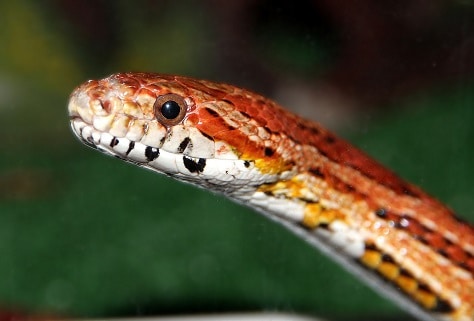
If there were a vicious snake roaming the wild somewhere with venom so powerful that it could melt through the doors of Fort Knox, there’d probably still be a reptile tamer somewhere trying to make a pet of it. People have been caught keeping Indian cobras and black mambas before, but the corn snake is regarded as one of the safest pets you could possibly have.
This docile snake inhabits a large chunk of the eastern USA, from the pine forests of New Jersey to the southern Florida keys. Another name is the red ratsnake, but it actually belongs to its own family: Pantherophis.
The corn snake lacks any venom, killing its prey via constriction instead, which it swallows whole, usually headfirst. Many fantastic colours have been bred in captivity, but wild corn snakes already look pretty fantastical, with bright red and orange colours and a distinct spear making on the skull. The average length is 0.8-1.2 metres, with males and females roughly the same (unlike boa constrictors, where females are longer). The record wild corn snake measured 1.8 metres.
| 2 | A silent guardian |
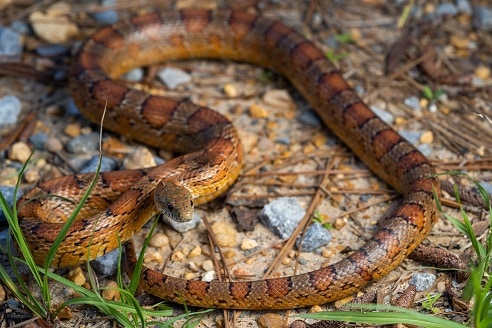
The corn snake is a well-researched species, but there’s one enduring mystery, the answer to which lies in the unknowable past – the origins of its name.
The first theory revolves around its belly scales, which are black and white like a set of dominoes. Supposedly, this resembled the kernels of old maize corn, AKA Indian corn or flint corn, a variety popular with early United States colonists.
The most popular theory however, relates to crop field pests. The corn farmers of the 1700s stored their harvest in corn crips, sheltered barns in hot parts of the country. These wooden barns attracted mice and rats in their thousands, but hot on their heels would be dozens of hungry corn snakes. Snakes are carnivores, and have no interest in bland, mushy corn, but the sudden influx of rodent pests would have been a feast for them. It’s said that early US farmers looked fondly on the corn snake, recognising them as an ally against crop nibbling pests as early as 1658.
| 3 | Their IQ is respectable |
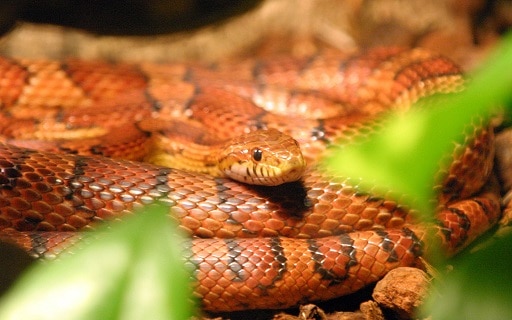
In the 1960s, experiments showed that snakes were as dumb as a rock, before the studies were widely criticised. Those early snakes were placed in water mazes, which were designed for fast, scurrying rodents and would never mimic a snake’s natural environment. A 1999 study took a different approach, placing 24 corn snakes in an elaborate black container the size of a small child’s paddling pool.
Immediately, the corn snakes began to circle the outskirts of the pool. The scientists installed various visual cues and pointers, to help the snakes navigate to the exit. These worked well, but most interestingly, the snakes remembered the cues when they were placed in the container for a second time. Their time of escape constantly decreased, beginning at 700 seconds and decreasing to 400 seconds in round 2. The smartest snakes navigated to the exit within 30 seconds. The scientists hid behind a thick black curtain and watched the proceedings on a video camera.
Other snake species could perform just as well, but the corn snake is the only one to have its intelligence proven.
| 4 | Where to find them |
If you’ve long desired to walk out your front door and track down a snake yourself, then the corn snake is an excellent candidate. Youtube has multiple videos of people scooping them up in their arms. They’re a fairly shy snake, hiding in old mammal burrows (often after eating the inhabitants) and even slithering through the channels of dead, decaying tree roots.
However, corn snakes are also spotted crossing roads, particularly during sunset or early evening, forcing annoyed people to stop their cars. Inevitably, this means that roadkill corn snakes are equally common. Corn snakes are mainly nocturnal, and their daytime lairs including rotting tree stumps, leaf piles, crevices under buildings, or garbage and sheet metal dumped next to buildings.
Unlike ratsnakes, they’re almost never found in attics, despite being superb climbers. They also have special places for their eggs – in 1961 and 1965, biologists found two clutches of eggs in the exact same sawdust pile in a North Carolina forest, 4 years apart. The average corn snake lays 12-24 eggs in a batch, and abandons them instantly.
| 5 | They’ve never killed a human |
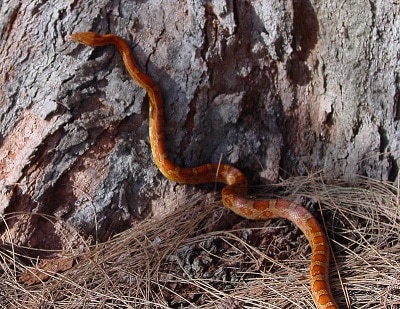
Most snakes don’t sit around plotting humanity’s demise in their spare time (except maybe black mambas). In fact, most snakes couldn’t care less about humanity, corn snakes included.
A spooked corn snake usually begins by shifting its body into wavelike kinks, and staying perfectly still like a statue. If it still feels threatened, then a corn snake will shift into the classic S-shape in preparation for assault, with its head raised up. It will vibrate its tail rapidly, a trait found in many snakes, but because corn snakes love to rest in leaf litter, this produces a unique buzzing sound. The snake will also lean back to show off its bright coloured chest markings, which it believes to be highly intimidating.
If the human leaves it no choice, then the corn snake will unleash a bluff strike, flying through the air, followed by an ear-piercing hiss. When picked up or pinned down, the more aggressive corn snakes will finally bite, but others will remain docile.
| 6 | They’re expert tree climbers |
The Amazon rainforest is full of exotic, multicoloured snakes that travel up tree branches as effortlessly as a ladder. However, the corn snake has the rare ability to slither up thick trunks which are almost vertical.
Corn snakes have an unusually flat belly, resembling a small loaf of bread from a side view, rather than a fully round tube. On that flat belly, their scales are angled jaggedly like a sawblade, which is perfect for digging into soft bark.
A corn snake doesn’t ascend vertically, but moves upwards in an S-shaped pattern, to minimise the weight on each body part. Once in place, they ascend slowly, but patiently. Corn snakes have been observed climbing sweet gum trees with a diameter of 3 feet, and elms trees with a diameter of 3.5 feet. Their reasons include pinching bird eggs from nests, or trying to find pockets of warmth when the forest floor cools down. The descent is equally careful, using the same S-shaped patterns.
| 7 | Fantastical colour morphs |
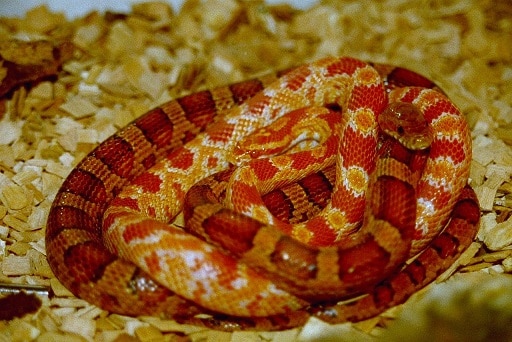
The corn snake is the most widely bred captive snake in America, and there’s now hundreds of different varieties, featuring more colours than a bowl of children’s cereal.
One example is the black corn snake, which lakes the anaethyrin pigment that produces the typical red and orange scales. A particularly popular variety is the candy corn snake, which keeps the red patches, but has light pink scales instead of orange, this time by removing certain melanin genes. Keeping one as a pet is a constant struggle not to eat it.
Colours aren’t the only breeding area, as the “blood red” carries a recessive gene which eliminates the vertical patterns. These genes came from a unique wild population discovered in Gainesville, Florida, and the result is a consistently red corn snake.
The blue-striped corn snake has barely any patterns at all, with a light blue background; it looks like a sleek and stealthy assassin. There’s even a scaleless mutant, which is a slight misnomer, as they still have scales on their bellies.
| 8 | Differences to more dangerous snakes |
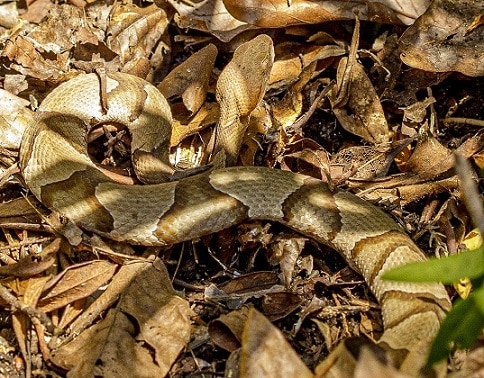
Corn snakes are commonly bludgeoned to death in the US after being mistaken for the venomous copperhead. But it’s simple to tell the difference, as the markings of a copperhead look closer to a wonky hourglass. The corn snake’s markings are blotchier and more random, and there’s also far more markings per animal. The red-orange tones are trickier to distinguish, but the corn snake’s are brighter and more neon.
In Florida, the corn snake is commonly mistaken for the northern mole kingsnake, which is far greyer and less vibrant in tone. The south Florida kingsnake is similarly dull, but the eastern ratsnake is trickier, with a lava-like orange colour in its Florida ranges. The key here is to spot the eastern ratsnake’s lack of patterns.
Most notably, the corn snake is the only species in the eastern US with the distinctive spear marking, with the tip pointing down the snake’s head. This spear marking is the corn snake’s unbeatable master ID key.
| 9 | They’ve conquered the world |
Being such a popular pet, corn snakes are now seeing constant escape stories worldwide, and few more than in the UK. 2010 saw a headline when Kasia Radochonska opened her airing cupboard one morning to choose some shoes, and found a bright orange snake staring back at her. It was a corn snake, and was chilling out in a pile of clothes. In 2015, a grey-coloured corn snake was relaxing in a comfy kitchen drawer in Marlow, when it felt the wooden boards shift below. A bright flood of light suddenly washed over it, and the next second, the corn snake saw a terrified woman leap back in shock.
The most recent was a 2021 incident where a Middlewich man headed to his shed for a bucket, and found a corn snake hiding under it. All he wanted was to wash his car.
Recently, there’s been fears that corn snakes could become naturalised in the UK and cause catastrophic damage to the local mice and voles, particularly given that the UK’s climate isn’t too dissimilar from New Jersey’s.
| 10 | The white-footed mouse |
The corn snake has a wide natural menu, including rodents, birds, bird eggs, baby rabbits and frogs. The corn snake isn’t like the Antiguan racer, which eats lizards almost exclusively. However, they do lean towards mice, which we know thanks to endless experiences with captive corn snakes. Every corn snake pro will tell you of their insatiable appetite for pinkies, frozen hairless baby mice bought in bulk.
In the wild, their top prey species is the 10cm white-footed mouse, a particularly cute species. Its eyes are huge and its feet are indeed white, and they secretly inhabit most of the US without anyone noticing. Beneath our noses, there are battles happening between the corn snake and this adorable mouse every day, in obscure rodent burrows unseen to the naked eye. Sometimes, the corn snake swallows them whole, but if you’re a mouse fan, then don’t worry, because in other instances the nimble mouse manages to escape. The only snake territory where the white-footed mouse doesn’t live is Florida.
| !! | BONUS: nerdy details |
Unlike pet corn snakes, which wait happily for a humanoid figure to fling a mouse to them, wild corn snakes have to fight hard for their survival. A 2016 study shed some light on their secret bird nest raiding techniques. Corn snakes in South Carolina were compared to two nearby species, the eastern racer (Pantherophis alleghaniensis) and common racer (Coluber constrictor). Scientists installed expensive video cameras at a site along the Savannah river, and waited patiently.
They discovered that of the three, corn snakes were the only exclusively nocturnal nest raider, invading nests between 20:04 and 02:20. Corn snakes were 5 times more likely to go for the nestlings than the eggs. One weird detail is that on numerous occasions, corn snakes followed fellow snakes up the trees and into the nests, like it was a deliberate hunting strategy, perhaps involving scent.
Corn snakes were cunning in other ways; they never attacked the mother bird, rousing her fury. Some corn snakes even slithered directly beneath the mother as she slept, or pushed sleeping adults out of the nest using their heads. Overall, corn snakes accounted for 25% of nest raidings by snakes, proving that they’re a major nemesis of birds in the wild.